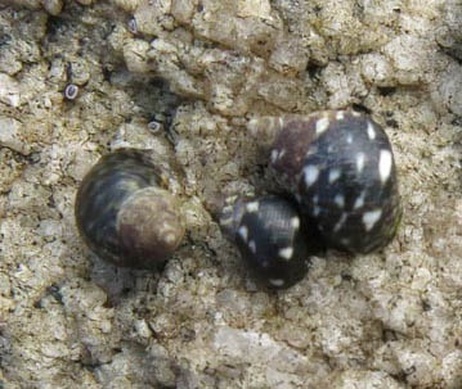Checkered periwinkle • Littorina scutulata
|
Identification
This species is distinguished by a checkered white pattern on a dark brown to black-purple shell. In some individuals, however, this pattern is absent. The height of the shell (up to 15 mm) is greater than the diameter, giving the shell a more slender appearance. The interior of the shell is somewhat purple, and some individuals have orange bands with white markings on the exterior of the shell. Similar Species The checkered periwinkle is similar to the Sitka periwinkle (L. sitkana) – another common intertidal grazer. However, Sitka periwinkles have a squatter shell shape, lack the white checkered pattern, and often have pronounced spiral ridges on the exterior of the shell. |
Habitat and Range
This species inhabits rocky shorelines in sheltered waters from northern Alaska to southern Oregon. Its range also includes Japan and Siberia. It migrates within the intertidal zone as the tide fluctuates, often aggregating in moist, shady bedrock crevices during low tide. This species is also known to occupy tidepools during the day.
Intriguing Information
This species feeds primarily on diatoms, microalgae, some species of macroalgae, and lichens using its rasping radula.
The checkered periwinkle is able to survive long periods without moisture by attaching itself to the substrate using a glue-like mucus. This essentially seals the operculum shut to preserve moisture until the next high tide or wave re-moistens the substrate.
This species reproduces throughout the whole year except summer. Eggs are deposited underwater in unique egg capsules that are enveloped in a coiled, sausage-like gelatinous mass. Larvae of this species are pelagic, and feed on phytoplankton for several weeks before settling.
This species inhabits rocky shorelines in sheltered waters from northern Alaska to southern Oregon. Its range also includes Japan and Siberia. It migrates within the intertidal zone as the tide fluctuates, often aggregating in moist, shady bedrock crevices during low tide. This species is also known to occupy tidepools during the day.
Intriguing Information
This species feeds primarily on diatoms, microalgae, some species of macroalgae, and lichens using its rasping radula.
The checkered periwinkle is able to survive long periods without moisture by attaching itself to the substrate using a glue-like mucus. This essentially seals the operculum shut to preserve moisture until the next high tide or wave re-moistens the substrate.
This species reproduces throughout the whole year except summer. Eggs are deposited underwater in unique egg capsules that are enveloped in a coiled, sausage-like gelatinous mass. Larvae of this species are pelagic, and feed on phytoplankton for several weeks before settling.
References
Carefoot, T. Littorina plena (Gould, 1849) In Klinkenberg, Brian. (Ed.) E-Fauna BC: Electronic Atlas of the Fauna of British Columbia. Lab for Advanced Spatial Analysis, Department of Geography, University of British Columbia, Vancouver. Accessed 2015-10-30.
Harbo, R. M. (1997) Shells & Shellfish of the Pacific Northwest. Madeira Park, BC: Harbour Publishing. P. 200.
Lamb, A., and Hanby, B. (2005). Marine Life of the Pacific Northwest [electronic version]. Madeira Park, BC: Harbour Publishing.
Authors and editors of page
Beatrice Proudfoot and Kelly Fretwell (2015)
Carefoot, T. Littorina plena (Gould, 1849) In Klinkenberg, Brian. (Ed.) E-Fauna BC: Electronic Atlas of the Fauna of British Columbia. Lab for Advanced Spatial Analysis, Department of Geography, University of British Columbia, Vancouver. Accessed 2015-10-30.
Harbo, R. M. (1997) Shells & Shellfish of the Pacific Northwest. Madeira Park, BC: Harbour Publishing. P. 200.
Lamb, A., and Hanby, B. (2005). Marine Life of the Pacific Northwest [electronic version]. Madeira Park, BC: Harbour Publishing.
Authors and editors of page
Beatrice Proudfoot and Kelly Fretwell (2015)




